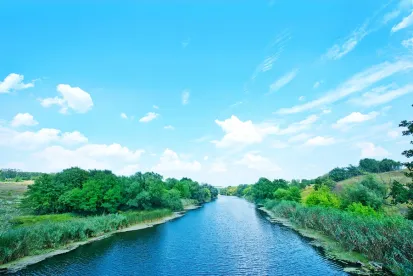The executive order asks agencies to repeal or revise an Obama-era rule defining the scope of the Clean Water Act and recommends adoption of a narrower standard articulated by the late Justice Scalia.
On February 28, US President Donald Trump issued an executive order asking the US Environmental Protection Agency (EPA) and the US Army Corps of Engineers (Army Corps) to repeal or revise a 2015 rule interpreting the term “waters of the United States,” which determines the jurisdictional reach of the Clean Water Act. The order further recommends that the agencies consider crafting a new definition based on the “continuous surface connection” test adopted by a plurality of the US Supreme Court in Rapanos v. United States, which would result in a significant contraction in the Clean Water Act’s scope from the Obama EPA’s 2015 rule.[1] The 2015 rule was met with extensive criticism by some stakeholders and gave rise to a flurry of litigation. A new rule issued in response to President Trump’s executive order is likely to do the same—resulting in continued uncertainty as to the proper scope of the Clean Water Act and possibly requiring further review by the Supreme Court to resolve the question.
Background
The scope of jurisdiction under the Clean Water Act has long been controversial. It is also an important issue for stakeholders such as farmers, developers, and energy companies that own or use properties that may contain a “water of the United States.” The scope of the act affects the application of a number of regulatory programs, including the section 402 point source discharge permit program, the section 404 dredge and fill permit program, and the section 311 oil spill prevention program.
The Clean Water Act applies to “navigable waters,” which are defined in the statute as “waters of the United States, including territorial seas.” EPA and the Army Corps, the agencies charged with administrating the Clean Water Act, have sought multiple times to define “waters of the United States” through rulemakings and regulatory guidance, and those regulatory efforts have been subject to numerous legal challenges. The US Supreme Court has weighed in on the issue three times, most recently in Rapanos v. United States.[2]Rapanos resulted in a fractured decision in which no interpretation received support from a majority of the court—Justice Antonin Scalia and three other justices articulated a test based on a “continuous surface connection,” while Justice Anthony Kennedy’s concurrence relied on whether there was a “significant nexus” to another water of the United States.[3] Because Justice Kennedy’s analysis provided the narrowest grounds for reversal, the “significant nexus” test has been understood by many as the controlling test post-Rapanos for what constitutes a water of the United States.
In May 2015, EPA and the Army Corps issued a new rule seeking to better define the Clean Water Act’s scope.[4] The agencies maintained that the final rule only clarified and limited the reach of the act, but many stakeholder groups concluded that the 2015 rule significantly expanded the existing interpretation of waters of the United States. Of particular concern to stakeholders were categorical inclusions of “tributaries” and waters “adjacent” to other waters of the United States, as well as the rule’s broad definition of what constitutes a “significant nexus.” Numerous lawsuits challenging the rule were filed, which are currently consolidated in the US Court of Appeals for the Sixth Circuit.
The Executive Order
On February 28, 2017, President Trump issued an executive order asking EPA and the Army Corps to review the 2015 rule and propose a new rule “rescinding or revising” it. The order also asks the agencies to consider defining waters of the United States “in a manner consistent with the opinion of Justice Antonin Scalia in Rapanos v. United States.” The order further directs the US attorney general to take appropriate measures regarding the ongoing litigation over the 2015 rule.
EPA and the Army Corps released a prepublication Federal Register notice the same day noting their intention to “review and rescind or revise” the 2015 rule pursuant to President Trump’s executive order. The agencies also acknowledged that they would consider adopting Justice Scalia’s test from Rapanos.
Implications
It likely will take years for the exact contours of the new regulation to be fleshed out by EPA and the Army Corps and for any ensuing litigation to be resolved. The process likely will start with the withdrawal of the Obama-era rule and the issuance of a new rule, including an explanation as to how the new rule fulfills the legislative intent of the Clean Water Act. The new rule will be subject to a public comment period.
If the agencies’ new rule is indeed based on Justice Scalia’s “continuous surface connection” test from Rapanos, it likely would entail a significant contraction in the scope of the Clean Water Act from existing practices and the Obama EPA’s 2015 rule. For example, a wetland next to a navigable river presumably would be covered by the act only if surface water from the wetland flowed into that river on a year-round basis, regardless of any subsurface flows. Under the 2015 rule, the same wetland could be covered under the act as a water “adjacent” to another water of the United States in the absence of a continuous surface connection. Many tributaries and ephemeral waters also likely no longer would be subject to regulation under the Clean Water Act if the “continuous surface connection” test is adopted. Such changes likely would be hailed by stakeholders that would have been prohibited from engaging in certain activities or obtaining permits under the 2015 rule, but criticized by environmental groups seeking to broadly protect aquatic resources.
Given the stakes and the contentious atmosphere regarding the scope of the Clean Water Act, any new rule is likely to be challenged in court. One issue that may be raised by challengers is whether a rule based on Justice Scalia’s “continuous surface connection” test is consistent with the requirements of the Clean Water Act as interpreted by Supreme Court decisions, including Rapanos. Opponents of the rule could contend that a “continuous surface connection” standard is inconsistent with the Rapanos court’s view of the limits of the Clean Water Act because five justices rejected Scalia’s test as too restrictive, and most lower courts have treated Justice Kennedy’s “significant nexus” test as the operative standard. Proponents of a new rule could counter that such a construction is nonetheless a permissible interpretation of the Clean Water Act (as evidenced by the plurality’s opinion in Rapanos) that is entitled to judicial deference.[5]
Environmental groups or others opposed to a new rule could also challenge the merits of the rule under the Administrative Procedure Act. Such a challenge could rely in part on the new rule’s departure from the 2015 rule, in which the Obama administration cited extensive scientific findings in support of its interpretation. While agencies can change their position, they must provide a “more detailed justification” if they rely on factual findings contradicting previous ones,[6] potentially heightening the agencies’ burden to provide support for a new rule.
In the interim, jurisdictional determinations under the Clean Water Act are likely to remain in a state of limbo. The 2015 rule has been stayed by the Sixth Circuit, technically leaving the rules and guidance pre-dating 2015 as the operative regulatory regime until the time that the stay is lifted or a new rule is promulgated. In light of the new administration’s expressed intent to limit the scope of the Clean Water Act, EPA and the Army Corps will be unlikely to assert jurisdiction over waters on the borderline of Clean Water Act jurisdiction until this legal limbo is resolved. The currently pending legal challenges also may be held in abeyance or remanded until the promulgation of a new rule, particularly given the executive order’s instruction to the US attorney general to take appropriate actions in pending litigation.
Ultimately, it likely will be years before the scope of the Clean Water Act is sorted out. And it may require a fourth trip to the Supreme Court for the justices to yet again wrestle with what are “waters of the United States.”
Additional Information
Additional information on the controversy that has surrounded efforts to define “waters of the United States” and the regulatory programs affected by the jurisdictional reach of the Clean Water Act can be found in the Clean Water Handbook, Fourth Edition, authored by Duke McCall and available from Bernan Press.
[1] 547 U.S. 715 (2006).
[2] Id.
[3] See id. at 717-18.
[4] 80 Fed. Reg. 37,054.
[5] See Chevron, U.S.A., Inc. v. Nat. Res. Def. Council, Inc., 467 U.S. 837 (1984).
[6] See FCC v. Fox Television Stations, Inc., 556 U.S. 502, 515 (2009).





 />i
/>i

